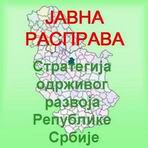Србија је 2017. године институционално и економски развијена држава, са адекватном инфраструктуром, компатибилна са стандардима ЕУ, са привредом заснованом на знању, ефикасно коришћеним природним и створеним ресурсима, већом ефикасношћу и продуктивношћу, богата људским ресурсима, са очуваном животном средином, историјским и културним наслеђем, у којој постоји партнерство јавног, приватног и цивилног сектора, као и једнаке могућности за све грађане.
Оваква визија проистекла је из стратегијских циљева одрживог развоја, а на основу темељне анализе препознатих потенцијала Србије, као и услова и ограничења у којима се остварују развојни циљеви. Остварење ове визије могуће је доследном имплементацијом темељних, стратешких и конзистентних циљева, који се заснивају на потребама грађана Србије за достизањем квалитетнијег живљења и бољег животног стандарда. Друштвени консензус подразумева да сви нивои власти препознају своју улогу у реализацији визије, а сви заједно утичу на институције државе како би се реализовали стратешки циљеви одрживог развоја.
Сагласно визији, дефинисани су национални приоритети Стратегије, као и стратешки и секторски циљеви одрживог развоја. Да би се они реализовали, Стратегија предлаже развојне инструменте и активности. Стратешки и секторски циљеви, приоритетне активности и развојни инструменти приказани су у поглављима која следе.



2 коментара:
Jedini je problem što ne uspeh da prepoznam koji su strateški ciljevi odnosno kako piše "темељних, стратешких и конзистентних циљева, који се заснивају на потребама грађана Србије за достизањем квалитетнијег живљења и бољег животног стандарда". Takođe nisam uspeo da prepoznam vezu između nacionalnih prioriteta i vizije. Čudno!?
Citiraću jedan tekst iz Vikipedije u vezi strateškog planiranja
It is practiced widely informally and formally. Strategic planning and decision processes should end with objectives and a roadmap of ways to achieve those objectives.
The following terms have been used in Strategic Planning: desired end states, plans, policies, goals, objectives, strategies, tactics and actions. Definitions vary, overlap and fail to achieve clarity. The most common of these concepts are specific, time bound statements of intended future results and general and continuing statements of intended future results, which most models refer to as either goals or objectives (sometimes interchangeably).
One model of organizing objectives uses hierarchies. The items listed above may be organized in a hierarchy of means and ends and numbered as follows: Top Rank Objective (TRO), Second Rank Objective, Third Rank Objective, etc. From any rank, the objective in a lower rank answers to the question "How?" and the objective in a higher rank answers to the question "Why?" The exception is the Top Rank Objective (TRO): there is no answer to the "Why?" question. That is how the TRO is defined.
People typically have several goals at the same time. "Goal congruency" refers to how well the goals combine with each other. Does goal A appear compatible with goal B? Do they fit together to form a unified strategy? "Goal hierarchy" consists of the nesting of one or more goals within other goal(s).
One approach recommends having short-term goals, medium-term goals, and long-term goals. In this model, one can expect to attain short-term goals fairly easily: they stand just slightly above one's reach. At the other extreme, long-term goals appear very difficult, almost impossible to attain. Strategic management jargon sometimes refers to "Big Hairy Audacious Goals" (BHAGs) in this context.) Using one goal as a stepping-stone to the next involves goal sequencing. A person or group starts by attaining the easy short-term goals, then steps up to the medium-term, then to the long-term goals. Goal sequencing can create a "goal stairway". In an organizational setting, the organization may co-ordinate goals so that they do not conflict with each other. The goals of one part of the organization should mesh compatibly with those of other parts of the organization.
U Strategiji održivog razvoja Republike Srbije sigurno treba uvažavati rečeno. Mislim da to nije slučaj sa ovim tekstom.
Постави коментар